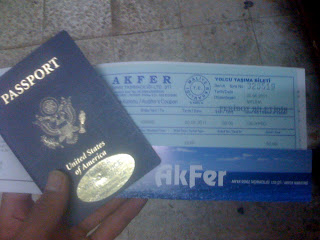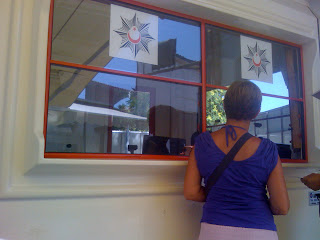My weakness
This trip is definitely allowing me to cope with my weakness.
As mentioned before, I’m not the best sleeper. At bad times, especially during testing period, I have to depend on wine to make myself relax. Or eat non stop until I’m so full that I get tired and can’t move, because I get hyper active and cannot stay still. It’s frustrating when you have trouble doing the most basic human behavior. Well anyway, this trip might be just what I need to overcome such disability (at least temporarily). Since starting this trip on June 12th, so about 40 days, I can count the number of times I stayed in a proper hostel with my right hand only. So it’s not hard to recall. Once in India, twice in Turkey, and once in Cyprus. All others nights I was either on a bus (or a train or ferry), at a terminal or an airport, and even some parks. I was also fortunate in India, Kenya, Egypt, and Rome for being able to stay at someone’s home. Thanks to them I think my accommodation expense is still below $100?
After sleeping on the overnight ferry from Tasucu, Turkey, to Girne, Cyprus
Intro to Cyprus
Like Kosovo, or almost all countries in the Eastern European region, Cyprus does not appear on a typical itinerary. Why? I’d like to know. I don’t think I’ll hear any creditable answer, assuming most responses will be something along the line of “why go there when I can go to [any country]”. That’s my image of a typical tourist response. However, I can respect those who are still reluctant to bring their family to a nation that, until recently, was heavily dependent on the UN to sustain safety. My question is, how many people are aware of the Cyprus struggle? The Turkish Cypriots and Greek Cypriots? The Green Line? Hnn..
Well since couple years ago I started getting more and more interested in the history of Cyprus. The history is not yet deep, however, for it was only in 1974 that the long struggle between the two Cypriots, the Turkish north and the Greek south, terminated. By “terminated”, I mean by external force, mostly by the Green Line drawn by the British that completely divided the country in half, and by the UN who helped enforce it. Basically until the green line was drawn in 1974, the Greeks and the Turks were going at it. Putting Christians and Muslims on an island alone? Not a good idea. It didn’t take long until both sides started to make aggressive attempts to eradicate the other. Greeks, who desperately wanted to reunify with its motherland Greece, were the more aggressive. They formulated a massive, deadly organization, called the EOKA, led by a former Greek military officer, whose sole objective was to wipe out every single Turk out of the island, and to retaliate against the British force who were also on the land to occupy. The result, blood.
To find out more, I went to a museum in Southern Cyprus. I was attracted by the name: “Museum of the National Struggle” (it was “The National Struggle Museum” on Lonely Planet). Yeh, not the best name for a museum. Imagine having to ask a local person “hey you know that museum about you guys struggling? Yeh, where is it?”
Wait there
This is really something; a referendum presented by the Greek side of Cyprus. Contains 94.7% of the population’s signature, all whom seeks reunification with mainland. It is said that the 5.3% who didn’t vote were teachers, policemen, and government officials who were restricted from signing. So basically, every single Greek Cypriot’s will is contained in this single book.
The actual rope used when Greek Cypriots (EOKA members) were executed by the British. All of them who killed Turks and fought British forces for freedom and return to mainland. This is only one of 3 ropes used. One was taken by the British after the war, and the other was burned. Photos are of Greek Cypriots who were actually hung using this one. It’s so well preserved and the information is precise only because these catastrophic events happened so recently.. (it's a coincidence that my shadow almost overlaps the loophole).
So there’s a bit of an intro to Cyprus. For simplicity look at the Koreas. North and South used to be a single nation until the UN imposed a boarder and created a buffer zone to ease the tension (though until today they are still technically at war). Cyprus is similar, except the line was first drawn by the British (literally with a green pen, thus the “Green Line”), and the boarder does not fully separate the legal entity of the nation, meaning Cyprus is still Cyprus, whereas North Korea is separate from it’s southern counterpart. However, after implementing this Green Line, the British, with tremendous aid from the UN force, initiated a huge project of placing the Turkish Cypriots on the northern half, the Greek Cypriots on the south, and placed military officials in between, in hopes of creating peace. That’s why Cyprus is so unique. When walking in the streets on the North side you hear prayer callings, mosques are everywhere, people eat doners (kebabs) and payment are in Turkish Lira (TL). But once crossing the line (and passing through security) into the south, you’re surrounded by Mediterranean restaurants, half naked men, and the pay is in Euro.
This is a map of the capital of Cyprus, known as Nicosia to the Turks and Lefcosia to the Greeks. It is located in the heart of the island. It’s hard to see on this map, but there is a green line that runs straight through this city, which further protracts to cut the country in half. The boundary that looks like a snowflake (which to me looks a hand grenade..) represents a wall, which was built by the Venetians for protection against the Ottoman invasion over 2000 years ago (which is when the Turks started living in Cyprus). So simple terms, when in the northern grenade you’re in Istanbul, and in the south you’re in Athens. The wall still stands today, and brings back sour memories especially to Greeks of older generation, who sees it as the starting point of the bloody conflict. But, like many other countries, most of the people knows how to deal with it. At the end of the day, it’s only a wall.
A view of the Turkish side of the wall, with a UN security tower standing right beside it. The two flags are of Turkey and Cyprus. Ever time there is a flag of Cyprus, there is always a flag of either Turkey or Greece.
Walking along the Green Line. So why the hell is it blue?
Oh right, the UN.
Imagine living along the Green Line. The family who lived next you yesterday becomes a far neighbor tomorrow, even though you can probably still yell at them from your backyard. Some of these houses, like the one above, were separated right through the middle. This photo was taking from Northern Cyprus (Turkish side), so this house is in northern territory. I forgot to mention that the people were giving several months to physically move to the side they belong to, and also to convert currencies to either Euro or Turkish Lira without additional fee.
The Reason
I was watching TV several years back. I can’t recall the details, but that was when I first learned about Cyprus and what’s going on there. There was a Turkish girl, at a park, who was responding to an interview. She was calling for unification of North and South Cyprus, and was wondering why she couldn’t play with her friend on the other side of the fence. In the background, there was that fence, right next to the slides and swings, with a photo of a military man on it that said “Forbidden Zone”.
This is the fence. The exact one the girl on the TV was pointed to. Except at her time, this gate was closed. Today this gate is open, but there is still UN personnels protecting the boarder. The park is called the Rocca Bastin, and it was known to be the only place in Niscosia, or in Cyprus, that each side can observe the daily behavior of the other side. Everywhere else, the gates were either too tall to look over, or the buffer zone disallowed getting close enough.
Technically my body is in Turkish half of Cyprus, and my fingers are in the Greek half.
Seeing something or somewhere from the same viewpoint of someone else is always interesting, because somehow it feels like you can share the feeling as well. It’s hard to imagine what the Turkish girl felt at the time, but one thing for sure is that it’s probably one of the heaviest walls to open in the world.
The Cross
Alright enough with the history lesson? Here’s some random photos of the city, and the crossing into the southern half.
Not quite sure what this is, but I thought about copying it. I would of if I wasn’t alone..
Along the wall. There’s an old soccer field.
The Northern half of Niscosia is as Turkey-ish as Turkey can get. Mosque, Turkish Delights, Cay, it’s all there
There were some small bazaars for tourists and…7-11?
Time to cross over the Green Line.
One of the few Turkish words I learned, Guile Guile to you too Turkey!




















No comments:
Post a Comment